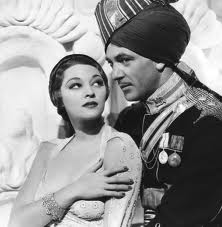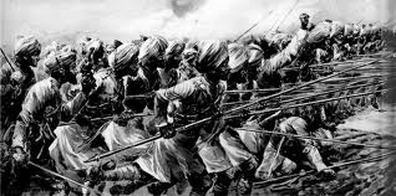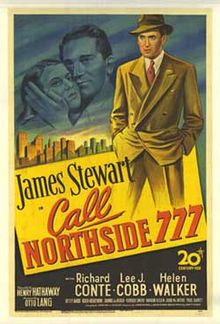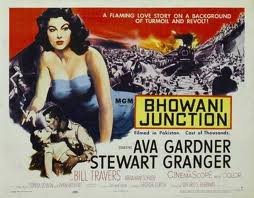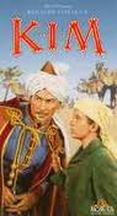Lives of a Bengal Lancer (1935) - Dir: Henry Hathaway
Film critic Adolf Hitler on why Lives of a Bengal Lancer was one of his favourite films
In 1937 Hitler told the British Foreign Secretary Lord Halifax that Lives of a Bengal Lancer was one of his favorite films. According to the Fuhrer, It showed a "handful of Britons holding a continent in thrall. That was how a superior race must behave and the film was compulsory viewing for the S.S."
Source: Ivone Kirkpatrick, The Inner Circle [London:Macmillan, 1959, p.97. Kirkpatrick was a senior Foreign Office official and diplomat who specialised in German affairs. He was sent by Churchill to interview Rudolf Hess after the later landed in Scotland in 1941.He rose to the top of the Foreign Office ranks in the 1950s.
Source: Ivone Kirkpatrick, The Inner Circle [London:Macmillan, 1959, p.97. Kirkpatrick was a senior Foreign Office official and diplomat who specialised in German affairs. He was sent by Churchill to interview Rudolf Hess after the later landed in Scotland in 1941.He rose to the top of the Foreign Office ranks in the 1950s.
About the movie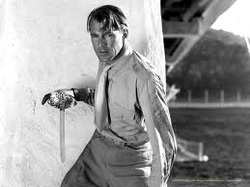
Henry Hathaway's 1935 movie Lives of a Bengal Lancer is largely forgotten today. Most people would associate 'Bengal Lancer' with an Indian restaurant or an Indian cricket team. Yet in its time the movie was the equivalent of aSpiderman movie today. It remains famous for making a longtime box office star of Gary Cooper. And it was one of the early 'buddy movie' successes, still popular today, in which a group of friends boldly fight incredible odds in the cause of country and glory. Harrison Ford's Indianna Jones' derring-do seems modelled on Cooper's character. It was also a breakthrough movie for its director, Henry Hathaway, who went on to make many first-rate actioners and westerns, several with John Wayne (e.g. True Grit, Sons of Katie Elder).
One feature of the film that would be not be appreciated by most modern film-goers is its seriousness. The tongue-in-cheek irony of the Indianna Jones films (already beginning to be a bit dated itself) is entirely absent. Although made in Hollywood with a Hollywood director and crew, it retains its source's stereotyped stiff-British-upper-lip ethos. Another negative feature is the movie's condescending andf paternalistic racial attitudes: British heroism and camaraderie is required to foil villainous natives and protect the childlike and naive good Indians. As that observant enthusiast of the film, Herr Hitler noted, Bengal Lancers maintains that a handful of Europeans can rule an entire continent of 'lesser' races. The movie is set in some vague part of the Northwest Frontier involving the '41st Bengal Lancers'. Gary Cooper is a headstrong officer who initially dislikes and then befriends two new subalterns, one of whom just happens to be the son of the regiment's C.O. There are bonding sessions, ungrateful rebellious Muslim tribes, a kidnapping, snake-charming, father-son conflict, a sultry woman of mystery, a torture scene (this is the one where the villain actually sneers 'We have ways of making men talk') and a heroic rescue scene. One feature of Bengal Lancers is significant. This movie is essentially a cavalry eastern, like KIng of the Khyber Rifles and North West Frontier / Flame Over India. It contains a vital element that was seized upon by the great John Ford and honed to perfection in his films about the U.S. Cavalry e.g. Fort Apache.This is the theme of the bonds and obligations of community (e.g. the regiment) and the tensions and conflicts that result, as well as the sustaining sense of cohesion and protection that ensue. It is this sense of communal commitment portrayed in Lancers that Ford employs so well in Fort Apache (below) and hisgreat films about regimental life in the Cavalry. |
About the book
The movie was based on the memoirs of Francis Yeats-Brown (1886-1944). Published in 1930, the book covered the author's time in the Bengal Lancers in the decade before World War I. Yeats-Brown had a privileged upbringing (Harrow and Sandhurst), and joined the British army in India. He soon became part of the Bengal Lancers, serving in the turbulent North West Frontier. During World War I Yeats-Brown served in the Royal Flying Corps in France and Iraq, gaining a DFC for bravery. He was a prisoner of war for two years after beiong captured by the Turks. After the war he reurned to the Indian army for four years. He then became a journalist. The publication of his book about military cantonment life in the Lancers, replete with tales of polo, pig-sticking, officers' pranks, lavish dances, complicated military etiquette and even his liason with an Indian dancing-girl was a success with critics and the public. The movie credits list the memoir as a 'novel', which may well bea more accurate description.
During the 1930s Yeats-Brown became associated with fascism, praising Franco and Hitler. During World War II he resumed his earlier career as an officer in India. |
Scenes from the movie
|
|
|
Who were the Bengal Lancers?
The Bengal Lancers that Yeats-Brown's best-seller describes were the regiment known as the 8th Bengal Lancers, stationed at Bareilly cantonment, in northern India, 100kms from the Himalayan foothills. They were part of Britain's largely locally recruited forces in India (as distinct from units of the British Army stationed in the sub-continent). They provide a perfect example of how so few Britons were able to rule such an enormous and heavily populated land: a key part of the imperial military presence consisted of local forces acting under British control in the form of the officer corps.
Just before Yeats-Brown took up his post these 'native' units, divided into the Bengal Army, the Bombay Army and the Madras Army,had been combined into a single unit, called the Indian Army. All these regiments had British officers. At that time there were nineteen regiments of Bengal Lancers stationed in various parts of northern India. The regiment depicted in the movie is entirely fictional.
The Bengal Lancers originally were a cavalry unit, and traced its parentage back to the private army of the East India Company, before becoming part of the Bengal Army after the Mutiny /Uprising. The fought in Afghanistan in 1879. In 1899 they were fitted with lances and became the 8th Belgian Lancers. Fittingly, the unit is now the 3rd Cavalry (armoured) in today's Indian Army. Several of the Bengal Lancer units fought overseas, including Egypt and Sudan (1882-5), the Boer War in South Africa and on the western front in World War I, including the Somme and Cambrai. Other units served in Mesopotamia (Iraq).
See Graham Watson, Indian Army, 1902, http://orbat.com/site/history/historical/uk/indianarmy1902.html; http://battledescription.com/bengal-lancer/ ; http://en.wikipedia.org/wiki/8th_Lancers)
Just before Yeats-Brown took up his post these 'native' units, divided into the Bengal Army, the Bombay Army and the Madras Army,had been combined into a single unit, called the Indian Army. All these regiments had British officers. At that time there were nineteen regiments of Bengal Lancers stationed in various parts of northern India. The regiment depicted in the movie is entirely fictional.
The Bengal Lancers originally were a cavalry unit, and traced its parentage back to the private army of the East India Company, before becoming part of the Bengal Army after the Mutiny /Uprising. The fought in Afghanistan in 1879. In 1899 they were fitted with lances and became the 8th Belgian Lancers. Fittingly, the unit is now the 3rd Cavalry (armoured) in today's Indian Army. Several of the Bengal Lancer units fought overseas, including Egypt and Sudan (1882-5), the Boer War in South Africa and on the western front in World War I, including the Somme and Cambrai. Other units served in Mesopotamia (Iraq).
See Graham Watson, Indian Army, 1902, http://orbat.com/site/history/historical/uk/indianarmy1902.html; http://battledescription.com/bengal-lancer/ ; http://en.wikipedia.org/wiki/8th_Lancers)
The painting above left shows Bengal Lancers triumphantly charging into battle against German cavalry at Ypres, 1914. The illustration above right shows them charging a German trench on foot. Eyewitness accounts prove the painting to be a fabrication. In fact, the military situation on the western front was so dire and manpower so depleted that the British flung the Lancers into action almost as soon as the unit arrived in France. This meant that the Lancers fought at Ypres as 'Dismounted Infantry', not as cavalry. They also fought in their light tropical outfit (plus a flannel shirt and jersey) and light boots; there was no time to equip them properly. It is unknown whether they were issued rifles rather than lances.
"The British Expeditionary Force holding the line of shallow, badly-made trenches from Ypres to La Bassee was subjected to a series of massive German attacks designed to clear Belgium and capture Calais. At a critical stage when the Germans seemed on the point of making a breakthrough the Indian Corps were brought up as reinforcements. In half waterlogged trenches, under constant attacks by German Infantry, who outnumbered them by at least seven to one, the Indian Corps fought with the utmost gallantry alongside the seasoned veterans of the British Expeditionary Force. At the end of four weeks of the heaviest fighting experienced in the war the line held. Ypres remained unconquered. In the words of Lord Harding, Viceroy of India: "It is to the abiding glory of the Indian Corps that it reached France in the first great crisis of the war. The only trained reinforcements immediately available in any part of the empire arrived in time to stem the German thrust towards Ypres and the Channel ports during the autumn of 1914. They consecrated with their blood the unity of India with the empire; and few indeed are the survivors of that gallant force."
Source: Wakefield, Col. J., and Lt. Col. J.M. Weippert, eds., 1986, Indian Cavalry Officer 1914-15 – Captain Roly Grimshaw:Tunbridge Wells, Kent, England, D.J. Costello,
"The British Expeditionary Force holding the line of shallow, badly-made trenches from Ypres to La Bassee was subjected to a series of massive German attacks designed to clear Belgium and capture Calais. At a critical stage when the Germans seemed on the point of making a breakthrough the Indian Corps were brought up as reinforcements. In half waterlogged trenches, under constant attacks by German Infantry, who outnumbered them by at least seven to one, the Indian Corps fought with the utmost gallantry alongside the seasoned veterans of the British Expeditionary Force. At the end of four weeks of the heaviest fighting experienced in the war the line held. Ypres remained unconquered. In the words of Lord Harding, Viceroy of India: "It is to the abiding glory of the Indian Corps that it reached France in the first great crisis of the war. The only trained reinforcements immediately available in any part of the empire arrived in time to stem the German thrust towards Ypres and the Channel ports during the autumn of 1914. They consecrated with their blood the unity of India with the empire; and few indeed are the survivors of that gallant force."
Source: Wakefield, Col. J., and Lt. Col. J.M. Weippert, eds., 1986, Indian Cavalry Officer 1914-15 – Captain Roly Grimshaw:Tunbridge Wells, Kent, England, D.J. Costello,
Henry Hathaway - neglected and underrated director

Henry Hathaway, 1898 - 1985.
Henry Hathaway directed more than sixty films, many of them with major stars such as John Wayne and James Stewart, but his work has been ignored by critics or favoured with polite evaluations such as 'competent' and 'professional'. There are several reasons for this neglect. Most of his films were apparently straight-forward actioners or westerns, genres frequently despised by some critics. His work also seems to lacks underlying themes and obsessions for critics to latch onto. He was not a notable stylist, although most of his films have a satisfying narrative fluency and exemplary pacing. Hathaway didn't write his own scripts or produce his own films. Finally, he worked contentedly within the Hollywood studio system for decades, first with Paramount then with Fox, directing movies on assignment for his producer bosses, rather like his contemporary, Henry King, director of King of the Khyber Rifles. Hathaway was not a Nicholas Ray chafing under the confines of studio regimes, although he occasionally angered them with his stubborn insistence on getting the lighting style he wanted from his cameraman. Directors like KIng and Hathaway who were at ease with the big studio restrictions never feature highly in critics' assessments. Yet Hathaway, like more favoured directors like William Wyler, was a stickler for detail, insisted on repeated takes of scenes until he was satisfied, and was highly knowledgeable about the use artists made of shade, light and perspective.
Hathaway's skills are best revealed in two genres that he specialised in making. The most important of these were the thrillers of the 1940s and early 1950s, with their semi-documentary, shot-on-location style and film noir characters and subjects. These include 13 Rue Madeleine , Kiss of Death, Call Northside 777 and Niagara. Early in his career Hathaway made Westerns (Heritage of the Desert and Trail of the Lonesome Pine) and he returned to that genre in the sixties, making a series of interesting, idiosyncratic movies, frequently with the theme of family commitment , often starring John Wayne. The best known of these are True Grit and The Sons of Katie Elder. Other westerns include Nevada Smith with Steve McQueen, and Five Card Stud.
|
|
|






